When you first got into horses, you were probably told to watch out when the horse put his ears back because that was a sign that he was going to bite or kick you. But that was it.
To this day, thousands of horse owners are no wiser than that about the body language of their horses. One of the best ways to learn more about a horse's body language and expressions is to simply spend some time watching horses together in all situations. Be especially sure to watch a mare and her foal interacting with other horses. Being able to read and correctly interpret a horse's reactions will help you understand why a horse behaves as he does, and you'll be less likely to blame him or punish him for it.
Most people don't know when a horse is going to run off, run over them, buck, kick, strike, when he's worried, frightened, defensive, bad-tempered, bored or toying with them. In teaching people to become horsemen, the single most important skill to develop is how to read a horse. That's what will keep you safe, help your diagnosis of problems and improve your approach and timing. Start by studying your own horse. Sometimes you won't have realised what you read until it is followed by an action. Then you can put two and two together.
Fear V Aggression
Here is where I think the greatest misunderstanding occurs. What a lot of people read as aggression in a horse is often fear. Horses by nature are flight-from-fear animals. They would much rather run away when threatened. But, if trapped, they will do whatever it takes to defend themselves: Strike, charge, kick out or worse.
Right Brain V Left Brain
The thing to understand here is the difference between right brain and left brain modes. A horse in his so-called right brain is not thinking. He is reacting purely out of instinct, because, in the wild, if a predator is trying to get him, it's his instinctive reactions that will save his life. He doesn't have time to think.
A horse in his left brain is thinking. He's confident, unafraid and deliberately does what he does, positive or negative. So how can you tell the difference? Here are some signals you might observe;
When he's blinking he's thinking...When he's not, he's hot.
This means if the horse is starry eyed, head highed, with nostrils dilated, has a tense jaw, a tense windpipe, or tight flanks, a tight and arched back, a tight tail, then he's scared and defensive. He's just got all his self-preservation reflexes strung tight. And if he hurts you, don't take it personally. A horse will do anything to save his life if he perceives he's being threatened. A scared horse will not look at you with two eyes. He will even look away as you approach, to put himself in position to get out of there.
A horse that makes the transition from right brain to left brain mode will blink his eyes, wiggle his ears, lower his head and lick his lips. At first you might only see the lip licking part, but more and more, you will start to perceive the other signs.
Don't blame a scared horse for acting like a prey animal. Learn to identify it so you can do something before it causes trouble. I believe that 90% of horse related accidents happen due to misreading a situation, along with having an unprepared horse or a horse that goes into self defence mode.
If you ride a horse that's learning to jump a barrel, you will be shocked at how differently he feels jumping it when in right brain v left brain mode. Remember that a scared or unconfident horse will have defensive body language. His head will be high and his muscles tense. Jumping over the barrel, those back muscles are strung like bows and they'll literally pop you off as they jump. It's very uncomfortable. However, once the horse becomes confident, he will feel completely different. His back will feel soft, he won't over jump, he'll be athletic, smooth and easy to ride as he jumps.
Uncertainly V Confidence
Uncertainty: The horse is right brained, head up, eyes starting, tense muscles, tight tail, fumbly footed. He'll rush into and out of the task. His tendency is to escape. He's not thinking.
Confidence: The horse is left-brained, has an alert but soft eye, muscles are not tense, places feet athletically, can do the task without hesitation but does not rush. He thinks his way through it.
This is what many people call a well trained horse. But if I can get you to see that this is confidence, not just training, it will open a whole new set of possibilities to how much you can do to get results with your horse.
These two concepts of right brain/left brain and confidence will serve you well in reading your horse as you play with him. You'll start to look at your horse with knowing eyes. Understanding his point of view will improve your timing and help you to know how much you should ask from a horse.
Insert chart
Reading Head and Ear Position
Doctor R M Miller pointed out that a horse has trifocal vision. Rather than having a lense that adjusts the focus, the horse has three distinct parts of the eye that offers three visual options. When his head is level, he's looking through the centre of his eyes and can see clearly all around him. To see something far off in the distance, the horse will lift his head high and look through the bottom of his eye. To focus on something close, the horse will coil his neck, bring his chin in and look through the top of his eye. That's why, when approaching a strange object, a horse will often arch his neck.
Head Position
A high head can therefore mean a couple of things.
1) The horse has senses something off in the distance that he needs to look at. His adrenalin will automatically flood his system as he prepares for flight if he is in danger.
2) The horse is worried, scared or unconfident.
Ear Position
The first expression most horse owners observe is when the horse's ears are back. When they are flat back, the eye is hard and the nose is wrinkled too. It certainly is a warning that something aggressive is about to happen. And a set of teeth or pair of heels often follows.
Observing horses interact with each other, you'll see that the ears back signal is most often used to drive another horse away. It says, 'if you don't move now, I'll make contact' and most horses learn how to get out of the way at an early age. They dominate each other this way. The horse that can move other horses with his expression is the more dominant horse. This is the horse that wins the ensuing confrontation should the other horses not move.
Ears laid back in aggression is only one of the ear expressions you should get to know. A horse's ear position will also tell you where its focus is. A horse has monocular vision. His eyes work independently of each other and you can often see by his ears where his visual or mental attention is being directed.
For example, if a horse being circled in a round corral is running scared, his ears will be half back with his mind being ultra perceptive to everything around him. As he calms down, he'll start to pay attention to you in the middle. You'll see the outside ear facing more forward in the direction of travel and the inside ear will be cocked towards you. Next, he'll stop and turn towards you. As you and your horse become more skilled at communicating at liberty in the round corral, your horse will have one ear on you most of the time to be perceptive to your signals.
A horse being ridden with great finesse and concentration (dressage) will have his ears cocked back in full attention to the rider and they will flick back and forth as he needs to focus on something in front or beside him. A scared horse will have his ears facing the thing he is scared of and they'll be really tight and tense. If the thing to be feared is in front of him, they'll be strained hard forward. If it's behind him, they'll be facing back but not be pinned flat as when he is aggressive.
The ears can also be a great indicator of relaxation. When working on a horse's confidence, I'll often play with his ears, pressing on the ends with my fingers and flipping them up and down to be able to feel how much more relaxed the whole horse is getting. They'll gradually go from being rigid to completely soft. A horse's tail will tell you the same thing, although I'm not recommending you go to the back of your horse to check this out. You can massage a tense tail until it is completely soft and know that the horse's whole body has become relaxed because his attitude is no longer defensive or scared.
The Arched Neck
Vertical flexion is a wonderful thing when a horse is confident and in his left brain. As his back rounds, neck bows, his chin gets close to his chest and his hindquarters become engaged. If he is scared, this is the exact position he will assume just before he rears, bucks or runs off. Reading this will cue you to not pull back with two reins.
When a stallion is courting a mare, he rounds his neck and back, gets powerful in the hindquarters and starts prancing - called passage in dressage - or dances in place - called piaffe. The same think will happen to you on a trail ride if you try to hold back an excited horse with two reins. If you keep holding on, the next thing he's going to do is lunge against the bit, rear and take off. Instead of pulling on two reins, bend your horse with one rein. This takes the power out of the hindquarters by disengaging them.
Get to know when vertical flexion is a positive or a negative expression in your horse. If you have mental, emotional and physical collection, that arched back will help your manoeuvres become better and better. But when a horse is scared, it's the last thing you want to see. Use lateral flexion to disengage the hindquarters and keep working on that mental and emotional fitness in your horse to achieve confidence first.
Reading the Horse in the 7 Games
There's a lot you can tell about a horse before you ever choose to fork a leg over him. The biggest trouble I see is people having difficulty distinguishing fear from disrespect and differentiating reactions from responses, especially in the first three principle games. In the last four purpose games, reading the horse will give you the insight into riding problems you are likely to encounter.
1 The Friendly Game
A fearful horse in the Friendly Game will try to escape first and fight second. A disrespectful horse will act aggressively without shying or acting skittish. Use a Carrot Stock as an extension of your arm in either case, one to help the horse get confident, the other to keep yourself at a safe distance.
2 The Porcupine Game (steady pressure)
A fearful horse will react rather than respond. He'll jump away from your touch. Don't confuse this with lightness, usually the horse needs more Friendly Game: 1) where the horse is passive, resistant, sluggish and dull and 2) where he's trying to play the game with you. In the first case, go higher up the phases, in the second, persist until the horse exhausts the undesirable behaviour.
3) The Driving Game (rhythmic pressure)
A horse that is scared when playing the Driving Game will be inclined to shy. He'll have a tendency to misread you, be impulsive and everything will mean run off. If the hindquarters don't yield well, beware of getting kicked. The disrespectful horse is inclined to run over you, constantly invading your space. He won't yield to you, if your turn towards him while leading.
4 The Yo Yo Game (forwards and backwards)
A horse who has a crooked Yo Yo Game on the ground will have difficulty changing leads and will go crooked when stopping or making transitions. If he is hard to back, he's hard to stop...or he'll stop on the front end instead of engaging his hind quarters. If he is sticky to come forward, he'll be hard to get going and probably travel on the forehand.
5 The Circling Game
A horse that doesn't disengage his hindquarters properly in the bring-back portion of the Circling Game is more inclined to brace and rear or run off when you ride him. He is also more inclined to kick out when scared. A horse that is sluggish and keeps slowing down in the Circling Game probably has more whoa than go, whereas the one who runs off will be easy to keep going, but hard to stop. If he circles with his head out, it could mean he's thinking of leaving or he lacks confidence.
6 The Sideways Game
A horse that will not yield well in the Sideways Game is more inclined to body slam you when afraid. Also, a weak Sideways Game will mean difficulty in getting the correct leads and flying lead changes. If he drags his hindquarters while going sideways, this could be a sign of impulsiveness and the tendency to run off when he feels any pressure in his forequarters.
7 The Squeezing Game
A horse that's unconfident in the Squeeze Game is more likely to have trouble with girthing, your leg aids, be unconfident crossing water or going over jumps, will be uncomfortable about getting in or travelling in trailers, getting into small spaces like starting gates, wash racks and roping boxes...and he'll have trouble with tight reins or any form of containment, including being tied up and probably has a tendency to pull back.
Finally, a horse that is right-brained and unconfident is apt to react defensively to just about anything you ask him to do. A horse that is left-brained and confident is more likely to think his way through things, be more athletic and less likely to get hurt or to hurt you.
You can gauge how much braver a horse is becoming by how long it takes for him to get confident with new challenges. A high adrenalin horse that used to be a lost cause once he got right-brained will come down off the adrenalin quicker and quicker until one day, he will not even want to go there. These horses learn to drop their heads quickly to get themselves off the adrenalin and trigger the release of endorphins that help them calm down and relax. Experience shows that a horse is inhibited from producing adrenalin when his head is lower than his withers.
The more you learn to read horses, the more you'll appreciate the simple value of the 7 Games and learn how to do more than just play them; you'll learn how to win them so your horse emerges calmer, smarter, braver and more athletic as well as build a language so you can communicate and teach your horse how to yield to you in every way.
You'll do so much more than just overcome opposition and resistance, you'll cause a profound mental and emotional shift in your horse as he learns to use his left brain as the primary mode. You'll also be safer, because you'll be able to read a horse's tendency. You'll know what's going to happen by what happens, before what happens happens.
I hope you'll be motivated to keep building your knowledge so you'll know how to keep safe by properly preparing your horse and making the right decisions in all situations.
Pat Parelli
|
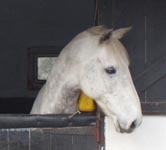

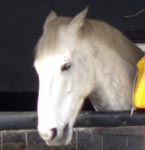
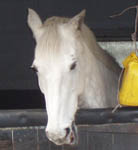
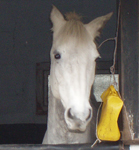
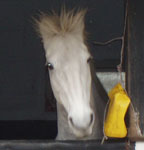
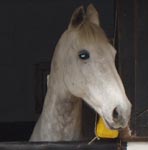
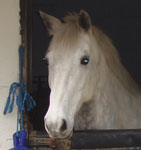
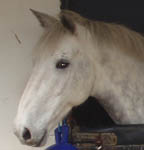
Examples of a range of expressions a horse can produce just looking out of his stable...
Photography Dawn Williams
|


![]()
![]()








